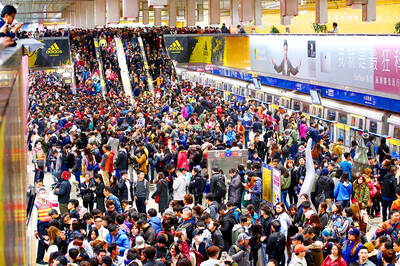A new white paper on air quality, which is expected to be released by the end of March next year at the earliest, is to encompass public suggestions, the Ministry of Environment said today at a news conference to discuss the paper.
The paper would serve as the foundation for developing the third phase of air pollution control policies, to be implemented from 2028 to 2031.
The paper is to integrate public demands for air quality, enhance communication and openly address public concerns, Department of Atmospheric Environment head Chang Shun-chin (張順欽) said.

Photo: Liao Yao-tung, Taipei Times
It would draw on international experience, incorporate emerging technologies and research to strengthen the science behind air quality policies and enhance international cooperation as well as domestic research, Chang said.
The ministry would establish a platform to consolidate public suggestions about Taiwan’s air quality starting on Jan. 8, creating a “good air wish list,” Chang said.
It would then hold a public forum before the Lunar New Year holiday to discuss the suggestions, he said.
The ministry is also holding a forum on sustainable clean air technology from Feb. 24 to 26, consolidating advice from experts and the public before publishing the white paper in March, he added.
The wish list encompasses four major aspects: improving air pollution from factories, vehicles and daily activities; reducing pollution and enhancing benefits under the net-zero transition; the impact of air pollutants, air-quality modeling and monitoring data; and strengthening the management of harmful pollutants, Chang said.
The influence of weather on air quality is a key aspect, but Taiwan has some of the least predictable weather in the world, said Lai Hsin-chih (賴信志), a professor of green energy and environmental resources at Chang Jung Christian University.
Europe and the US’ air quality regulations have a complete set of tools, encompassing climate and emissions, to set a timeline to achieve their goals, he said.
Only by designing a common scientific platform and using common tools would Taiwan be able to stand together and discuss how to improve the nation’s air quality, he said.
The results of NASA’s Kaohsiung-Pingtung 3D Air Quality Experiment (KPEx) revealed new insights that could serve as the basis for the third phase of air pollution control policies and determine how much air pollution could be reduced, said Lin Neng-huei (林能暉), a professor of atmospheric sciences at National Central University.
The second phase of the air pollution control plan, which runs from this year to 2027, sets a goal for the national average of PM2.5 concentration to reach 13μg/m³ by 2027, with an additional target of 12μg/m³ by 2030.
Considering that air quality issues persist in central and southern Taiwan during certain seasons, the target for these regions has been set to 15μg/m³.
Another goal of the plan is to reduce the national number of eight-hour ozone red alert days by 80 percent compared to 2019 levels.

READY: The CGA said it closely monitored China’s maritime exercise, deployed vessels to shadow the Chinese ships one-on-one and set up emergency response centers Chinese navy and coast guard ships have returned to China, signaling the end of a massive maritime exercise, authorities said yesterday. The Coast Guard Administration (CGA) released images it said showed Chinese vessels sailing north in rough seas past Taiwan on Thursday, on their way to China. “All the Chinese coast guard went back to China yesterday, so although they have not officially made any announcement, we consider it over,” CGA Deputy Director-General Hsieh Ching-chin (謝慶欽) said. Beijing has not confirmed the drills and the Chinese Ministry of National Defense did not say whether the maneuvers had taken place when asked at a

People can take the Taipei MRT free of charge if they access it at Nanjing Sanmin Station or Taipei Arena Station on the Green Line between 12am and 6am on Jan. 1, the Taipei Department of Transportation said on Friday, outlining its plans to ease crowding during New Year’s events in the capital. More than 200,000 people are expected to attend New Year’s Eve events in Taipei, with singer A-mei (張惠妹) performing at the Taipei Dome and the city government’s New Year’s Eve party at Taipei City Hall Plaza, the department said. As people have tended to use the MRT’s Blue or

PUBLIC TRANSPORT: As some roads would be fully or partially closed, people are advised to take the MRT, with services expanded to accommodate more riders This year’s Taipei Marathon, which has obtained its first gold label certification from World Athletics, is to be held from 5am to 1pm tomorrow and would have 28,000 participants. The race is to start from the Taipei City Plaza and would go through major roads throughout the city, with traffic control implemented from 6am to 2pm, officials said. The Taipei Mass Rapid Transit (MRT) system and New Taipei City MRT Circle line would start operating at 5am on the day of the race, they said. The race would cover Renai Road, Xinyi Road, Hangzhou S Road, Aiguo east and west roads,

Taipei is participating in Osaka’s Festival of Lights this year, with a 3m-tall bubble tea light installation symbolizing Taiwan’s bubble tea culture. The installation is designed as a bubble tea cup and features illustrations of Taipei’s iconic landmarks, such as Taipei 101, the Red House and North Gate, as well as soup dumplings and the matchmaking deity the Old Man Under the Moon (月下老人), affectionately known as Yue Lao (月老). Taipei and Osaka have collaborated closely on tourism and culture since Taipei first participated in the festival in 2018, the Taipei City Department of Information and Tourism said. In February, Osaka represented